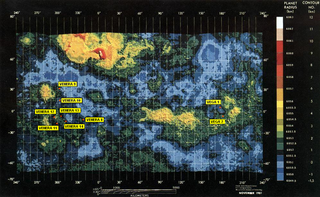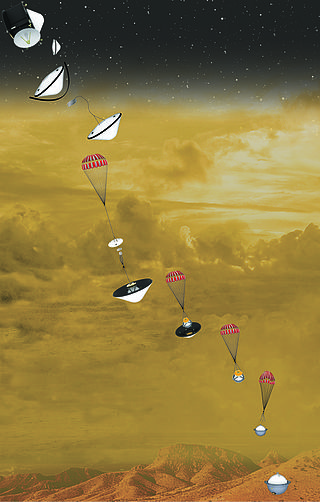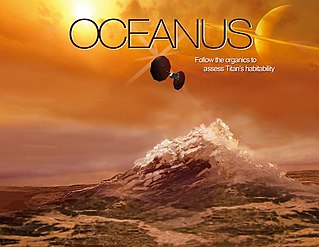Related Research Articles

The Venera program was the name given to a series of space probes developed by the Soviet Union between 1961 and 1984 to gather information about the planet Venus.

The Pioneer Venus project was part of the Pioneer program consisting of two spacecraft, the Pioneer Venus Orbiter and the Pioneer Venus Multiprobe, launched to Venus in 1978. The program was managed by NASA's Ames Research Center.

The Magellan spacecraft was a 1,035-kilogram (2,282 lb) robotic space probe launched by NASA of the United States, on May 4, 1989, to map the surface of Venus by using synthetic-aperture radar and to measure the planetary gravitational field.

Mars 96 was a failed Mars mission launched in 1996 to investigate Mars by the Russian Space Forces and not directly related to the Soviet Mars probe program of the same name. After failure of the second fourth-stage burn, the probe assembly re-entered the Earth's atmosphere, breaking up over a 320 km (200 mi) long portion of the Pacific Ocean, Chile, and Bolivia. The Mars 96 spacecraft was based on the Phobos probes launched to Mars in 1988. They were of a new design at the time and both ultimately failed. For the Mars 96 mission the designers believed they had corrected the flaws of the Phobos probes, but the value of their improvements was never demonstrated due to the destruction of the probe during the launch phase.

The Discovery Program is a series of Solar System exploration missions funded by the U.S. National Aeronautics and Space Administration (NASA) through its Planetary Missions Program Office. The cost of each mission is capped at a lower level than missions from NASA's New Frontiers or Flagship Programs. As a result, Discovery missions tend to be more focused on a specific scientific goal rather than serving a general purpose.

Observations of the planet Venus include those in antiquity, telescopic observations, and from visiting spacecraft. Spacecraft have performed various flybys, orbits, and landings on Venus, including balloon probes that floated in the atmosphere of Venus. Study of the planet is aided by its relatively close proximity to the Earth, compared to other planets, but the surface of Venus is obscured by an atmosphere opaque to visible light.

Venera-D is a proposed Russian space mission to Venus that would include an orbiter and a lander to be launched in 2029. The orbiter's prime objective is to perform observations with the use of a radar. The lander, based on the Venera design, would be capable of operating for a long duration on the planet's surface. The "D" in Venera-D stands for "dolgozhivuschaya," which means "long lasting" in Russian.

The surface of Venus is dominated by volcanic features and has more volcanoes than any other planet in the Solar System. It has a surface that is 90% basalt, and about 65% of the planet consists of a mosaic of volcanic lava plains, indicating that volcanism played a major role in shaping its surface. There are more than 1,000 volcanic structures and possible periodic resurfacing of Venus by floods of lava. The planet may have had a major global resurfacing event about 500 million years ago, from what scientists can tell from the density of impact craters on the surface. Venus has an atmosphere rich in carbon dioxide, with a density that is 90 times that of Earth's atmosphere.

The Venus In Situ Explorer (VISE) has been a lander mission concept proposed since 2003 by the Planetary Science Decadal Survey as a space probe designed to answer fundamental scientific questions by landing and performing experiments on Venus.

VERITAS is an upcoming mission from NASA's Jet Propulsion Laboratory (JPL) to map the surface of the planet Venus in high resolution. The combination of topography, near-infrared spectroscopy, and radar image data will provide knowledge of Venus's tectonic and impact history, gravity, geochemistry, the timing and mechanisms of volcanic resurfacing, and the mantle processes responsible for them.

DAVINCI is a planned mission for an orbiter and atmospheric probe to the planet Venus. Together with the VERITAS mission, which will also study Venus, it was selected by NASA on 2 June 2021 to be part of their Discovery Program.
The selection process for Mission 13 and 14 of the Discovery program began in February 2014, as NASA drafted an Announcement of Opportunity (AO) for the next Discovery mission. The winning mission proposals received $450 million in funding towards mission development and construction, along with bonus funding if missions were able to incorporate certain technologies. For Discovery Mission 13 and 14, NASA received 28 proposals, 16 of which notably centered around small Solar System bodies. Lucy, a multiple-flyby mission to the Jupiter trojans, and Psyche, a mission to the metallic asteroid 16 Psyche, were announced as the winners of the competition in January 2017, with launches in October 2021 and October 2023, respectively.

Oceanus is a NASA/JPL orbiter mission concept proposed in 2017 for the New Frontiers mission #4, but it was not selected for development. If selected at some future opportunity, Oceanus would travel to Saturn's moon Titan to assess its habitability. Studying Titan would help understand the early Earth and exoplanets which orbit other stars. The mission is named after Oceanus, the Greek god of oceans.

SPRITE was a proposed Saturn atmospheric probe mission concept of the NASA. SPRITE is a design for an atmospheric entry probe that would travel to Saturn from Earth on its own cruise stage, then enter the atmosphere of Saturn, and descend taking measurements in situ.
Venus In Situ Atmospheric and Geochemical Explorer (VISAGE) is a proposed Venus lander mission that would perform atmospheric and surface science investigations.

Venus In situ Composition Investigations (VICI) is a concept lander mission to Venus in order to answer long-standing questions about its origins and evolution, and provide new insights needed to understand terrestrial planet formation, evolution, and habitability.

EnVision is an orbital mission to Venus being developed by the European Space Agency (ESA) that is planned to perform high-resolution radar mapping and atmospheric studies. EnVision is designed to help scientists understand the relationships between its geological activity and the atmosphere, and it would investigate why Venus and Earth took such different evolutionary paths. The probe was selected as the fifth medium mission (M5) of ESA's Cosmic Vision programme in June 2021, with launch planned for 2031. The mission will be conducted in collaboration with NASA, with the potential sharing of responsibilities currently under assessment.
Suzanne E. Smrekar is an American geophysicist and Deputy Principal Investigator for the Mars InSight lander and the principal investigator for the planned VERITAS space probe to Venus.

The Venus Emissivity Mapper (VEM) is a spectrometer for mapping the surface composition of Venus through a distinct number of atmospheric spectral windows. It will be one of the two payloads onboard the VERITAS mission, and represents the VenSpec-M channel of the EnVision mission's spectrometer suite.
References
- 1 2 3 4 Smrekar, Suzanne; Dyar, M. D.; et al. (eds.). Venus Origins Explorer (VOX), a Proposed New Frontier Mission (PDF). The Venus Exploration Analysis Group.
- 1 2 3 4 5 6 Venus Origins Explorer New Frontiers Proposal. Van Kane. Future Planetary Exploration. 1 October 2017.
- ↑ Smrekar, S. E.; Elkins-Tanton, L. T; Hensley, S.; Campbell, B. A, B. A. (2014). VERITAS: A mission to study the highest priority Decadal Survey questions for Venus. American Geophysical Union - Fall Meeting 2014. NASA. Bibcode:2014AGUFM.P21B3912S.
- ↑ NASA's New Frontier Mission Will Search For Alien Life Or Reveal The Solar System's History. Elana Glowatz, IB Times. 20 December 2017.
- ↑ Paller, M.; Figueroa, H.; Freeman, A.; et al. (2015). VISAR: A Next Generation Inteferometric Radar for Venus Exploration (PDF). Venus Lab and Technology Workshop (2015). Universities Space Research Association.
- ↑ VERITAS (Venus Emissivity, Radio Science, InSAR, Topo-graphy And Spectroscopy): A Proposed Discovery Mission. (2016) Smrekar, Suzanne; Dyar, Melinda; Hensley, Scott; Helbert, Joern. The Smithsonian/NASA Astrophysics Data System.
- ↑ The Venus Emissivity Mapper (VEM) Concept. J. Helbert, D. Wendler, I. Walter, Thomas Widemann, Emmanuel Marcq, A. Maturilli, S. Ferrari, Mario D'Amore, N. Muller, Melinda D. Dyar, et al. HAL Archive.
- ↑ Cupid's Arrow: An Innovative Nanosat Mass Spectrometer to Sample Venus' Upper Atmosphere. (PDF) Murray Darrach, C. Sotin, S. Madzunkov, E. Neidholdt. HEM's Workshop. 2015.




